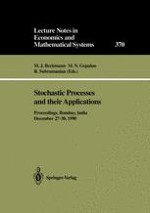1991 | OriginalPaper | Chapter
Incentives and Regulation in Queues
Author : Kashi R. Balachandran
Published in: Stochastic Processes and their Applications
Publisher: Springer Berlin Heidelberg
Included in: Professional Book Archive
Activate our intelligent search to find suitable subject content or patents.
Select sections of text to find matching patents with Artificial Intelligence. powered by
Select sections of text to find additional relevant content using AI-assisted search. powered by
It is known that customers seeking service in a queuing system tend to overcrowd the facility when making their individual decisions based on a consideration of the benefits they derive from the service and the cost due to waiting at the system. To obtain an optimal utilization it is necessary to restrict entry by pricing. In this paper, the effect of applying the operating cost of the service center to its users is analyzed.In a single class customers case it is shown that when service center cost is applied, the optimal arrival rate may be higher than the individual equilibrium rate and thus a subsidy to increase the arrival rate to the system may be required. For the multi-class case the class dominance property states that for optimal utilization, the system should be dominated by a single class of customers. It is shown here that when service center costs are absorbed by the users, there exists conditions for which the class 1 users may restrict their own arrival rate in order to allow class 2 customers to utilize the facility. The conditions for such are derived for the FIFO and nonpreemptive priority rules.
